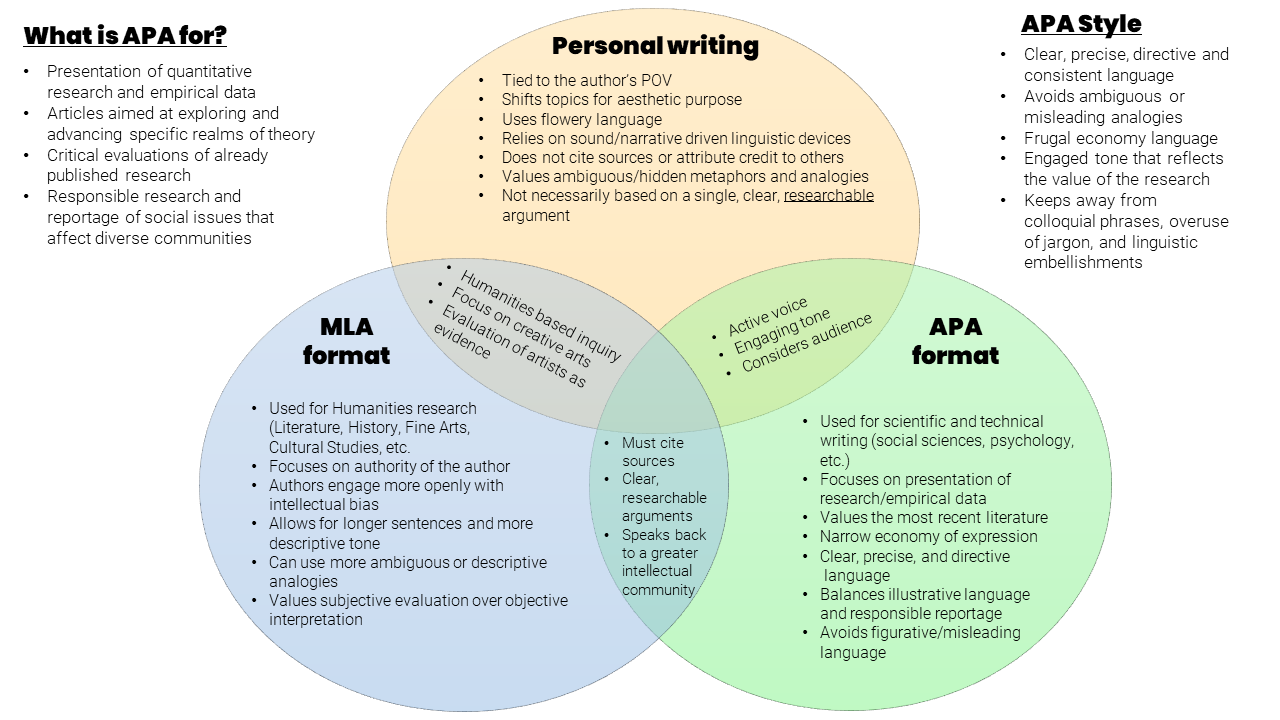APA citations
A guide to formatting in APA style
The information below is drawn from the Publication Manual of the American Psychological Association, 7th ed. In order to find a more in-depth explanation of any item below, be sure to buy a copy for yourself or check one out from VCU Libraries.
Formatting and Styling Guidelines
Select a header below to learn more about writing in APA.
- Language should be clear, concise, and plain. Ask:
- Were you as specific (in descriptions and numerical values) as possible?
- Are all your pronouns clear and specific?
- Check for:
- Proper labels for your subjects/participants
- Use of active voice when possible
- Correct verb tense & subject-verb agreement
- After your first draft, during revision you should remove any:
- Nonessential words
- Colloquial expressions
- Jargon
- Need a quick guide to punctuation? Look for quick tips in Ch. 6 of the Publication Manual of the American Psychological Association, 7th ed.
- Font options: Calibri (11pt), Arial (11pt), Lucida (10pt), Times New Roman (12pt), Georgia (11pt)
- 1-inch margins
- Double spaced
- Separate page
- Centered on page in bold
- For a class assignment: under title include your full name, institutional affiliation, course number, instructor’s name, and assignment due date
- For publication: your full name and institutional affiliation
- Running Head: in all caps and justified to the left
- Separate page
- Center the heading: “Abstract”
- Short, concise, non-evaluative summary of the paper
- 150-250 words
- Header: use a SHORTENED TITLE (in all caps); justified to the left
- Continue page number in header (justified to the right)
- Use headings for sections of paper
APA in-text citations use the author-date model (Author, Year). ALWAYS include page numbers when quoting directly (Author, Year, p. #).
When citing three or more authors, list only the first author and et al. (Author et al., Year).
Avoid both undercitation and overcitation. Undercitation occurs when you do not consistently cite your information and can lead to plagiarism or self-plagiarism. Overcitation is excessive repetition of citations in each sentence when author and subject matter remain the same, causing distraction for the reader.
Introduce the idea with a signal phrase that includes the author’s last name followed by the date of publication in parentheses.
Ex. 1: According to Campbell (1995), strong coops are important for poultry (p. 21).
Ex. 2: According to Campbell (1995), “When owning poultry, it is important to maintain a secure coop” (p. 21).
WARNING: Avoid quotations unless absolutely necessary.
- New page
- Simple title of “References” centered
- Only include entries cited in paper
- Each entry has a hanging indent of 0.5"
- Authors’ names need to be inverted (last name, initials) and in alphabetical order
- Double spaced
- Include: Author(s) name(s), date of publication, title of source, title of container (with any volume number or issue number when possible), and DOI
- DOI (Digital Object Identifier) is a unique number assigned to published work that links to a permanent location online.
- Print materials may include a DOI as well (if there is a digital version of the source), and this should be listed when possible in the Reference entry
- When capitalizing titles, capitalize both words in a hyphenated compound word: Farm-Raised Chickens
- Only the first letter of the title and the first letter after a colon (if there is one) should be capitalized. Ex. “Critical race methodology: Counter-storytelling as an analytical framework for education research.”
- Italicize the titles of longer works such as books, edited collections, movies, television series, documentaries, or albums: LOST, Criminal Minds, Harry Potter
- Put quotation marks around the titles of shorter works such as journal articles, articles from edited collections, television series episodes, and song titles
- Ex. 1: “Hurt,” by Johnny Cash (song title)
- Ex. 2: “Saint Lucifer.” (T.V. series)
- Only use gendered language when necessary
- When possible, use your participants’ names
- Avoid assuming heterosexual orientation and use the most up-to-date language
- Only specify race if it is relevant to the study
- Use the currently preferred name for groups
- Vary placement of socially dominant groups in lists
- Avoid stereotypes
